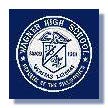 |
 |
 |
 |
|
Contributed by Debbie "Duckie" Goldey Wardick '76 1918 As early as 1918 the Leonard Wood School at Ft Stotsenberg had six-rooms for grades 1-7. It is believed that schools in the Philippines have the distinction of being the only military-operated schools in the Pacific prior to WWII. 1930-Dec 8, 1941 Also at Ft Stotsenberg, the Dean Worcester School was in operation till the Japanese attacked Clark Field. 1946 In January information was requested by the 13th Air Force concerning establishment of a school facility at Clark Field. 1947-48 On July 7th, 1947 the first school age children begin to attend Clark Field Dependents Schools, grades 1-12. The HS name is “Clark Field High School”. School year ends April 14, 1948, following the approx. schedule of Filipino schools. 1947-1948 Bernie Charland ‘48 recalls long car rides daily from Camp O'Donnell to Clark Field for classes. 1948 In February the first school Newspaper is published by upperclassman. In a contest to name it, the winner is the “Panther Scratches”. 1947-48 First graduating class
from Clark Field Dependents School, 3 Seniors Graduate.
1948 In August the “Clark Crier” Vol. 1 Issue 1 is published bi-monthly for dependants of Clark Air Force Base by students of Clark High School. 1949 First Clark Elementary School in sawali-sided buildings for grades 1-8 located near the site of the future Wurtsmith/Wagner High School site. Grades 9-12 were located in six sawali buildings near what was then the NCO club. 1949 The first teachers are recruited from the United States arriving in June; 8 stateside teachers and 6 dependent wives completed the Faculty. 1950 In the summer, Clark Dependent School is moved to the building previously used by the DUG-MANED central control office for the reconstruction of Clark and will later be renamed Wurtsmith Memorial School. 1950-1960 School mascot name is known as Bomber’s. 1950’s Teen Club is now referred to as the “Teen Age Club”. 1951-52 There are six teachers for 82 students in grades 7-12. 1952-53 Eleven primary, five intermediate, and eight high school teachers lead about 700 students from grades 1-12. 1952-53 The high school expanded into the buildings south and east of the main building. 1954 Clark Dependants’ School is renamed Wurtsmith Memorial High School – in the memory of Major General Paul Bernard Wurtsmith, a former commander of the 13th Air Force, who lost his life in an airplane crash on Mt Cold, near Nashville, North Carolina. 1953-54 Enrollment grows to about 800 including nursery and kindergarten. Faculty consisted of 30 teachers. The school nurse was a first lieutenant from the Base Hospital. 1956-57 Wurtsmith Memorial High School “Post Script” Published Vol. VI No. 4 1956-57 There are 44 teachers instructing students and elementary class size ranged from 30-42. 1957-58 Grades 7-12 transfer to individual wooden buildings and Quonsets at the former Chapel Center on the site that will eventually be renamed Wagner High School. The old site becomes Wurtsmith Elementary School. 1958-59 To improve the caliber of instruction an elementary curriculum coordinator, two counselors, a music director, and teachers for remedial reading, Philippine culture, art and PE are added to the Faculty. 1958-59 Of the 82 teachers, 61 were at Clark for the first time. 2000 students attend Clark Schools. 1958-59 The first issue of the “Post Script” to be published by a printer in February. All previous school newspapers had been hand typed by students. 1960 January begins with the construction of the new high school. HS students move temporarily back to the former DUG-MANED building. 1960-61 WMHS teams adopted the name “Falcons” to replace “Bombers as their trademark. 1961 The new Wurtsmith Memorial High School building is opened in the spring on the former site of the Ft Stotsenberg base picnic grounds and is the first school to be approved for air-conditioning. 1961-62 Regina Lamb '63 wrote an essay to win the contest to rename the school. 1962 October 1 - Wagner High School and Zettel Gymnasium Dedication ceremonies take place - The HS is named after LTC Boyd David Wagner (nickname "Buzz"). He severed as a Pilot in WWII. He died in a plane crash near Florida November 29, 1942. 1962-63 The first class to graduate from the newly named Wagner HS consists of 53 Senior’s. 1964-65 The escalation of the Vietnam War caused a need for more classrooms. Buildings in the old hospital staging area became Wurtsmith Annex I School, housing grades 4-6. 1965-66 With over 5000 students enrolled, administrators and faculty numbering 209, including 150 new employees, transient quarters across from the Base Library became Wurtsmith Annex II for four 4th grade classes. 1966-67 In January 1966 overcrowding is somewhat relieved with the completion of a new gym, music room, and science room located next to the high school. Annex I, with grades 7-8 occupy this new location. Annex II is torn down and classes move to the first two wings of the high school. Because of overcrowding the kindergarten and grades 7-8 were put on double sessions. 1966 The 1st Dirty Bird Contest was a Tug-O-War between the 67 Senior & 68 Junior boys held over the creek across the street from WMS. Seniors won and the stuffed Dirty Bird was donated by Maryann Lieb and brought (appropriated) by Donnie Green and Barb Slupecki. 1967-1982 Mr. Bruce Taft was Vice-Principal and then Principal of WHS. He held this position longer than any other administrator. 1967-68 More than 7200 students attend Clark’s five schools. The new Hill School opened and housed grades 3-4. This school will later be named V.I. Grissom, for one of the first astronauts, killed in a space accident. Kindergarten and grades 1-2 are located at Wurtsmith Main. Wurtsmith Annex housed grades 5-6. Double sessions were needed for grades 3-8. 1967-68 WHS students volunteered 20,000 hours to assist the Red Cross attend to the casualties of the Vietnam crises. 1968-69 Enrollment reaches all time peak of nearly 8000 students. This record was never broken. 163 Senior’s graduate at years end. 1969 In January, Kindergarten became a part of DOD. 1969-1980 The newspaper at WHS is called the Falcon Crier. 1969-1970 Split sessions were held for grades 4-12 and kindergarten during height of CAB being built up at the end of the Vietnam War. About 1400 students were enrolled at WHS. 1970 The original Dirty Bird is stolen and destroyed, then replaced by a wood carved copy. 1970’s Teen Club is split into Junior and Senior Teen Club’s. 1970-71 One thousand fewer students enroll for classes, yet double sessions remain in effect. The new Wurtsmith Memorial School is completed for grades 2-4. This is the last year “old Wurtsmith” is used for classes. 1970-71 The Student Government Association raises $850 to help fund the new pavilion between WHS and WMS, which is ready for use in September 1972. 1970’s-1991Mr. Vern Harmelink, who hands out certificates to those who can swallow and retain a balut, sponsors “The Balut Club”. This tradition is kept alive and still practiced at reunions that Mr. Vern Harmelink attends. 1972-73 In September 1972, Lily Hill Middle School opens for 5th and 6th graders. It stands at the foot of a hill used as a Japanese command post during WWII. Two modulux-type buildings are added to Grissom School and for the first time Grissom holds a one-session schedule for 3rd , 4th and special education. 1973 Feb 13, Operation Homecoming - POW's of the Vietnam War come home via CAB – The number one request by returning POWs at Clark was to leave the hospital and visit children, so on Feb 14, 1973 300 children at Grissom Elementary greeted the first group of returnees to Clark schools. 1972-73 WHS has 248 graduating seniors, which is an all time high for Clark schools. 1974 Dec 5, More than 5000 students participated in a “Day with Dad” accompanying their sponsors to work. This was the largest operation of its kind ever attempted in the DOD school system worldwide. A pilot program in career education was begun at WMS for handicapped children. 1974-75 MacArthur Elementary School opened while still under construction for K-5 classes in August 74. 1975 April, Operation Baby Lift – Mattresses being used for the WHS play “Once Upon a Mattress” are spread across the gym floor and hundreds of students volunteer to help children while production of the play ceases. Educators from the 6 schools at CAB volunteer over 3000 hours of their time. 1976 WMS Gecko Gazettes is published. 1976 Bicentennial celebrations are conducted at all the schools at CAB. The Bicentennial graduating class adopted red, white and blue for their class colors and is named “The Most Spirited Class of 76”. Lily Hill Middle School students changed their name from the “Apaches” to the “Patriots”. 1976 June 30, The DOD Schools, Pacific Area, became DoDDS Pacific Region. 1977 March, The Wagner Falcons won its first Far East basketball championship in Yokota, Japan. 1977 June, The Falcon Crier and Fledgling received an international rating and award for SY 76-77. 1978 New age technology reached WHS in the form of the Sperry Univac 90/30 computer. From 1978-87, Mr Bruce F Hawkins was the WHS Computer Specialist. 1980-81 The School Newspaper was renamed the Balut Courier. 1980-81 Escalating fuel prices bring a halt to all on base buses. Bicycles become the most popular transportation mode, tripling over last year’s numbers. Mopeds become so popular that a new parking lot at Wagner sprouts between the guidance office and the teachers’ lounge. 1982 April, John-Thomas Calderon Ngo, senior at WHS, is selected from more than 3,000,000 seniors as a finalist in the Presidential Scholars program. 1983 Early in the year, Clark experienced severe power shortages. Schools returned to tropical schedule and often held classes outside for light and the hope of a faint breeze. 1985-86 Clark schools feel the implications of “Plans for a Balanced Federal Budget”. Field trips are cut, sports and honor band competitions were canceled, supply orders reduced, and a hiring freeze to replace teachers was implemented. 1986-87 More cutbacks in programs to meet the Balanced Federal Budget include delaying the start of the school year until Sept 4th. 1989 Construction of the new high school campus on the plain below MARS Hill, overlooking the golf course, begins. Several buildings connected by walkways enclose an open court. Plans are made to renovate the old WHS into the new WMS complex, grades 5-8. Plans were made to demolish Lily Hill School and construct a new elementary school in its place. 1990-91 The new WHS building
was opened with the first graduating class to attend, but graduation takes
place at Subic Bay after evacuations of CAB due to Mt Pinatubo erupting
just one week before the school year ends.
1960-80’s Wagner HS was used for evening classes for the University of the Philippines division located on CAB. (we are not sure if it was used in the 50’s and/or 90’s) Other School’s that we competed
with in various competitions in the PI were:
Students came from various
American Base installations in the PI including:
In Dec 1995, Gary McClellan
’75 founded the web site known as Wagner High Online Alumni.
|
|
|
|
|